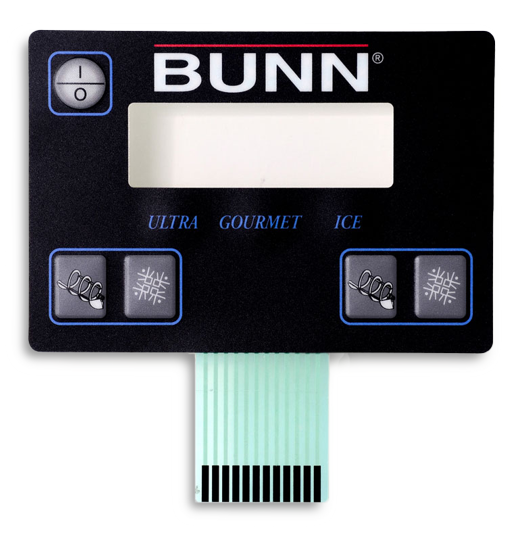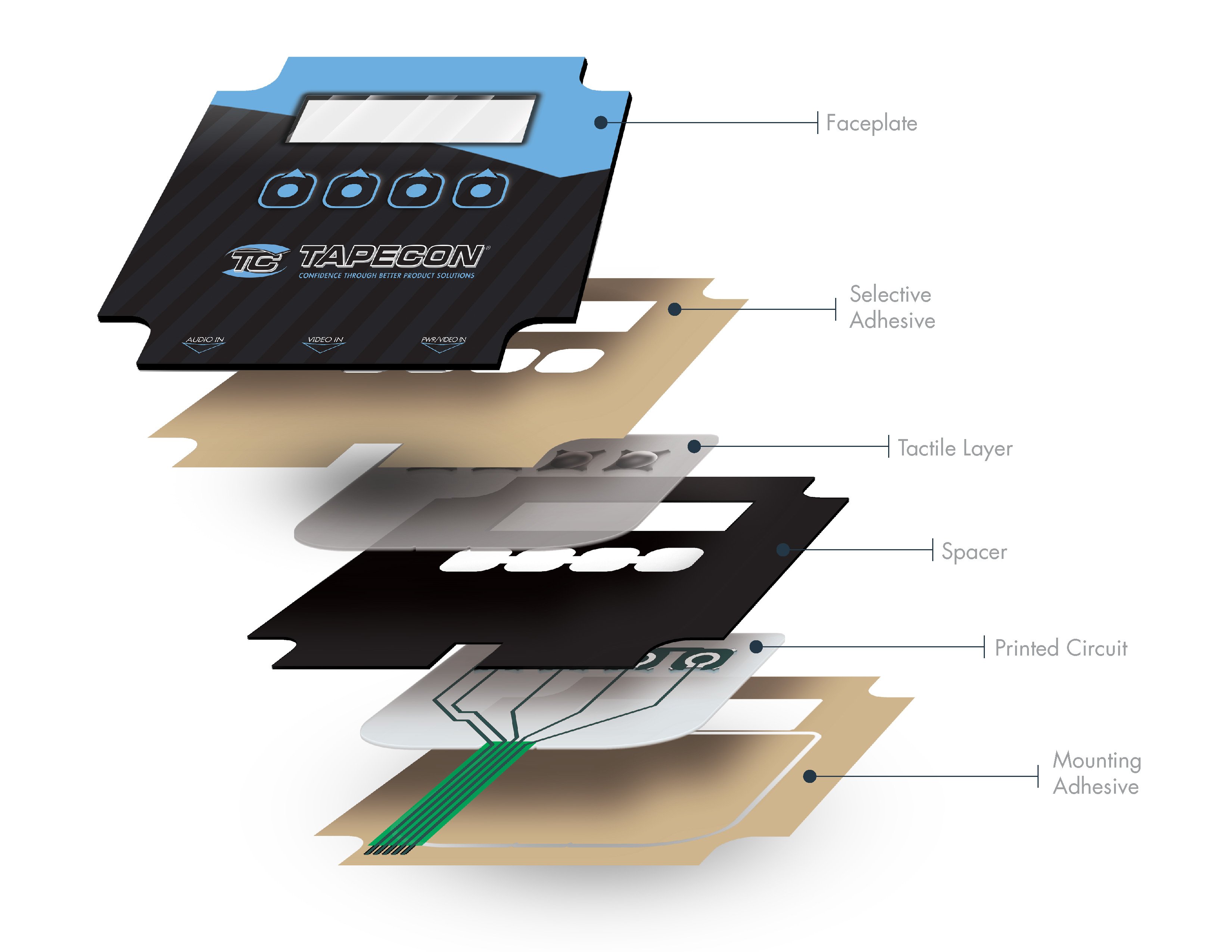See Why We’re a Top-Rated Membrane Switch Manufacturer
See Why We’re a Top-Rated Membrane Switch Manufacturer
Blog Article
Understanding the Value of Membrane Switch in Modern Electronic Devices and Their Applications
Membrane switches over act as a vital element in modern-day electronic devices, supplying an efficient interface for user interaction. Their lightweight and adjustable nature makes them suitable for a variety of applications across varied sectors. Recognizing their vital parts and benefits can give understandings right into their expanding importance. As modern technology remains to development, the development of Membrane changes increases questions regarding their future applications and style advancements. What lies ahead in this dynamic area?

What Are Membrane Buttons?
Membrane buttons are necessary components in modern electronics, working as individual interfaces that facilitate interaction between customers and gadgets. These buttons contain several layers, including a graphic overlay, an adhesive layer, and a circuit layer, every one of which interact to develop a long lasting and useful user interface. The layout enables for a level, low-profile remedy that can be personalized pertaining to dimension, form, and visual look, making them appropriate for numerous applications, from consumer electronic devices to clinical devices. The tactile comments given by Membrane switches over enhances customer experience, while their resistance to dust and wetness makes them suitable for challenging atmospheres. Furthermore, Membrane buttons can incorporate functions such as backlighting and published graphics, even more broadening their usability. Their versatility and toughness make them a recommended choice in industries where dependability and convenience of use are critical, inevitably adding to the seamless operation of contemporary digital devices.
Key Parts of Membrane Switches Over
While numerous components contribute to the performance of a membrane switch, 3 key layers play substantial duties in its layout and operation. The top layer, typically made from a sturdy polymer, works as the interface for user interaction, commonly including printed symbols and graphics. Underneath this is the spacer layer, which keeps the necessary range in between the leading layer and the circuit layer. This spacer layer guarantees that the switch activates only when pushed, protecting against unintended inputs. Finally, the circuit layer contains conductive traces that complete the electrical circuit when the leading layer is dispirited. These traces can be made from numerous products, consisting of copper or silver. Together, these elements produce a robust and dependable device that is compact and functional, suitable for a large range of electronic applications, from home appliances to medical tools. Recognizing these vital elements is crucial for appreciating the total functionality of Membrane switches.
Advantages of Using Membrane Changes

Membrane Switch Manufacturing Process
Comprehending the Membrane switch manufacturing process exposes the complex actions associated with generating these crucial parts. The procedure normally begins with the style phase, where specifications and layouts are developed using specialized software application. Following this, the graphic overlay is printed on a flexible substratum, typically using high-resolution printing techniques to guarantee clarity and precision.Next, the adhesive layers are applied, which offer to bond the numerous elements together. The circuit layers, made from conductive inks or materials, are then published onto a separate substratum. These layers are carefully straightened and laminated flooring to create a practical switch.After assembly, the switches undertake checking to confirm performance and resilience. Quality control actions are applied throughout the procedure to identify and rectify any kind of problems. The completed Membrane switches are packaged and prepared for circulation, prepared to meet the needs of contemporary electronic applications.
Applications of Membrane Switches in Various Industries
Membrane buttons are increasingly made use of throughout various sectors, especially in clinical devices and consumer electronic devices. In the medical area, they give dependable control interfaces for tools that need exact procedure. Similarly, in consumer electronics, these switches enhance user communication by offering receptive and sleek user interfaces.
Medical Equipment Control
Various modern medical tools use Membrane switches for streamlined procedure and enhanced individual communication. These switches offer a trusted, sturdy interface for a variety of applications, consisting of diagnostic devices, person monitoring systems, and surgical tools. Their personalized designs enable for details layouts that can accommodate the special demands of healthcare professionals, making sure instinctive navigating and efficient access to necessary features. Additionally, Membrane switches are resistant to pollutants, making them appropriate for clean and sterile settings. The tactile feedback they provide can enhance individual self-confidence, lowering the threat of errors during vital medical treatments. In general, the integration of Membrane switches in clinical equipment substantially adds to improved functional effectiveness and patient security in health care settings.
Customer Electronics Interfaces
In the domain name of consumer electronic devices, Membrane switches play a crucial function in boosting interface throughout a wide variety of gadgets. These buttons are important to products such as remotes, microwaves, and video gaming consoles, giving a easy to use and effective interface. Their design enables a smooth combination of graphics and capability, allowing suppliers to create smooth, modern-day aesthetics without compromising functionality. Membrane buttons are additionally recognized for their resilience, typically withstanding comprehensive usage and direct exposure to different environmental problems. Furthermore, they can incorporate attributes like backlighting and responsive feedback, more improving the user experience. As consumer demands for sophisticated yet intuitive interfaces expand, Membrane switches proceed to be a vital part ahead of time electronic device functionality.
Layout Factors To Consider for Membrane Changes
Creating reliable Membrane changes needs cautious interest to numerous elements that affect both performance and customer experience. One important factor to consider is the option of products, as they can influence sturdiness, tactile responses, and aesthetic appeal. Choosing a suitable adhesive is essential for guaranteeing long-lasting bond and resistance to environmental factors.In enhancement, the design and layout of the switch have to suit individual communication, with button dimensions and spacing maximized for ease of use. The unification of graphics and labeling ought to focus on quality and visibility under different lights conditions.Consideration of electrical attributes, such as actuation pressure and button sensitivity, will boost the responsiveness of the Membrane switch. The style needs to suit manufacturing processes to ensure cost-effectiveness and prompt manufacturing. Overall, a well-thought-out style improves both the capability and site here the customer experience of Membrane switches in contemporary electronics.

Future Trends in Membrane Switch Technology
As innovation remains to develop, Membrane switches are poised to incorporate brand-new innovations that will improve their performance and application in numerous fields. One considerable pattern is the consolidation of versatile and resilient products, which will certainly boost the lifespan and integrity of these buttons. Improved surface textures and customizable graphics are additionally prepared for, enabling more instinctive user interfaces.Moreover, the assimilation of clever innovation, such as touch-sensitive surfaces and haptic feedback, is anticipated to improve customer communication, making Membrane switches more interesting and receptive. Additionally, breakthroughs in published electronic devices will make it possible for extra intricate wiring within thinner profiles, additionally increasing layout possibilities.Sustainability will certainly additionally play a crucial function in future developments, as suppliers discover eco-friendly materials and production processes. In general, these patterns will ensure that Membrane changes stay pertinent and vital in a increasingly electronic and interconnected world.
Regularly Asked Concerns
How Do Membrane Switches Contrast to Conventional Mechanical Buttons?
Membrane switches over deal advantages over traditional mechanical buttons, consisting of minimized size, try here lighter weight, and boosted sturdiness. They typically provide a secured surface area, improving resistance to dust and moisture, making them suitable for diverse applications.
What Materials Are Generally Used in Membrane Switch Building And Construction?

Can Membrane Switches Over Withstand Extreme Environmental Issues?
Membrane switches can endure extreme ecological problems, depending upon their style and materials. Top quality constructions often include longevity versus temperature fluctuations, moisture, and direct exposure to chemicals, making them appropriate for various requiring applications throughout markets.
How Lengthy Do Membrane Switches Typically Last Prior To Failure?
Membrane switches over usually exhibit a life-span varying from 1 to 10 million actuations, depending on factors such as use frequency, ecological problems, and manufacturing top quality. Routine maintenance can expand their sturdiness and operational dependability considerably.
Are Membrane Changes Customizable for Certain Applications?
Membrane buttons are without a doubt personalized for certain applications. They can be tailored in performance, dimension, and design, permitting producers to meet special individual needs and enhance product aesthetics while preserving functional efficiency and toughness. Membrane switches are crucial parts in contemporary electronic devices, serving as individual interfaces that assist in interaction in between users and gadgets. The tactile comments provided by Membrane changes improves individual experience, while their resistance to dirt and wetness makes them excellent for challenging atmospheres. The consolidation of graphics and labeling need to prioritize clearness and exposure under numerous lighting conditions.Consideration of electric features, such as actuation pressure and switch sensitivity, will enhance the responsiveness of the Membrane button. Boosted surface structures and personalized graphics are also expected, permitting for more intuitive user interfaces.Moreover, the assimilation of clever technology, such as touch-sensitive surfaces and haptic responses, is expected to boost individual interaction, making Membrane switches more receptive and appealing. Membrane explanation changes offer advantages over typical mechanical switches, consisting of decreased dimension, lighter weight, and enhanced longevity.
Report this page